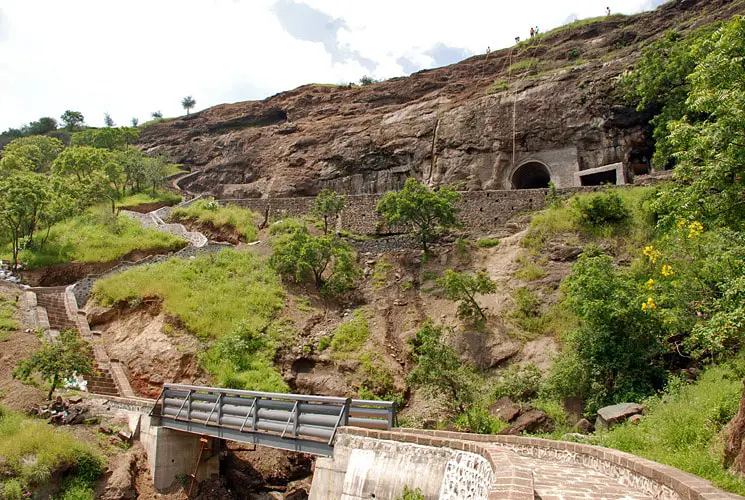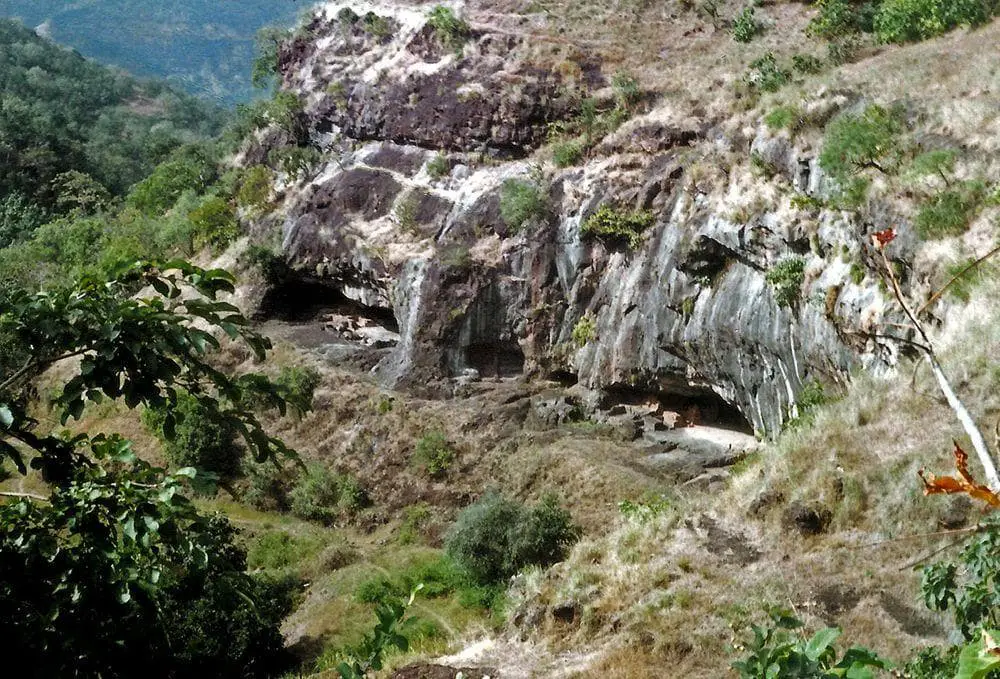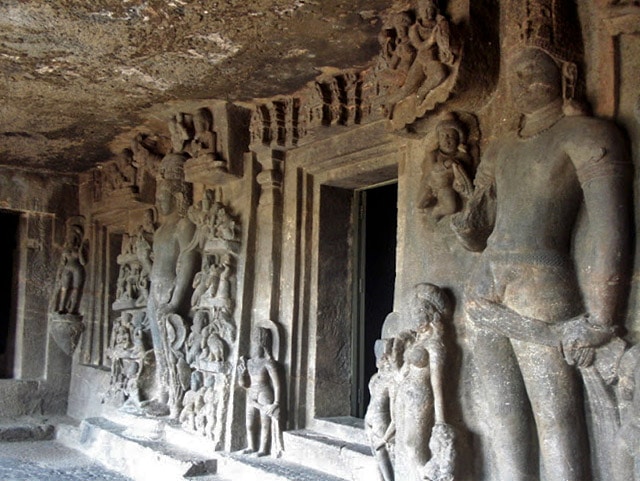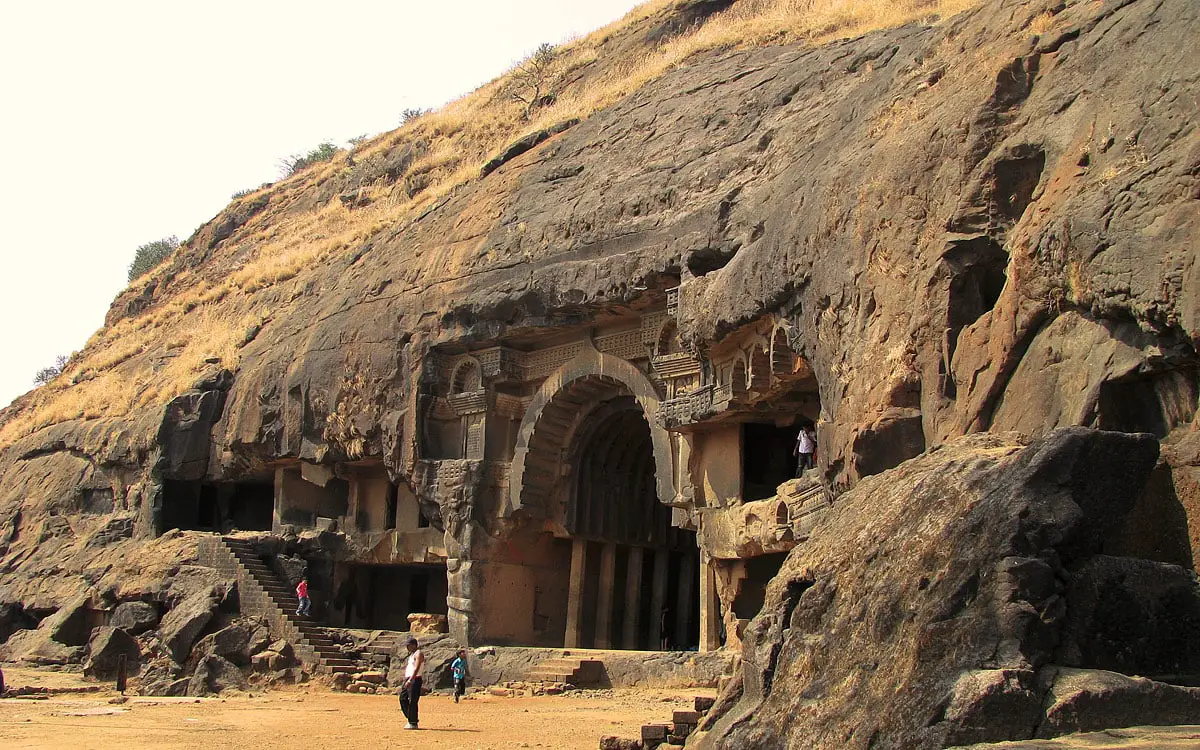World 🢖 Asia 🢖 India 🢖 Maharashtra
Buddhist shrines 🢔 Religious architecture 🢔 Archaeological wonders 🢔 Categories of wonders
Wonder
Aurangabad Caves

 In short
In short
The not so far Ajanta Caves and Ellora Caves have overshadowed the values of another complex of beautiful cave temples – Aurangabad Caves.
 45.3%
45.3%
GPS coordinates
Location, address
Age
Religion
Map of the site
If you see this after your page is loaded completely, leafletJS files are missing.
 In detail
In detail
Aurangabad Caves contain some of the most beautiful sculptures known to be created by Indian artists of classical period.
Location
Caves are located few kilometers north of Aurangabad city, on steep slopes of a hill running roughly from east to west, some 20 m above the surrounding plain. They were unknown to Europeans until the middle of the 19th century.
Aurangabad is located close to the ancient trade route and rather close to Paithan – the ancient capital of Satavahanas, contemporary Pratishthana. Buddhism in India was spread by traders and Buddhist cave temples often were established along such trade routes. These temples and monasteries served also as safe inns for weary travelers.
In total there are 12 Buddhist caves divided into three groups. The westernmost caves comprise the first group and are numbered from 1 to 5. The second group is located some 500 m further to the east and includes caves 6 to 9. The easternmost group is located 1 km further to the east and includes caves 10 – 12.

Caves are cut in the basalt of rather bad quality, with fractured zones where the rock is not suitable for carving. This has prevented the creation of large caves – builders of caves had to avoid the parts of bad quality rock. Some excavations were stopped as fractures were reached.
Description
Caves are carved in a cliff in the time period from the 2nd – 3rd century AD to the 7th century AD.
The oldest are caves 1 and 3, possibly excavated in the 2nd – 3rd century AD.
Cave 1 is unfinished monastery – vihara. The ceiling of the verandah has collapsed. Only the portico and pillars are finished. Verandah contains three panels depicting Buddha with Padmapani and Vajrapani.
Cave 2 is chaitya – square shrine with a circumabulatory around it. It contains a square shrine. A colossal statue of Buddha is located in the shrine. The entrance in this shrine is adorned with depictions of Avalokitesvara on either side. Cave 2 contains several sculpted images of Buddha.
Cave 3 is large monastery – vihara. It contains pillared verandah with cells on either end. After verandah comes the main hall with square pillars, with two cells on both sides, with a pillared porch and a shrine. Pillars in the hall are arranged so that they form a square, these columns are richly decorated with floral and geometric motives. Architrave above the pillars is adorned as well.
Cave 4 is chaitya griha of Hinayana order. Unfortunately, it is in bad shape due to soft rock – the front part of this cave has collapsed – there still are visible stumps of pillars of this part. 12 beautiful octagonal columns in the rectangular hall have been preserved, they are adorned with carvings depicting scenes from Jataka tales – tales about the previous births (jāti) of Buddha. These columns divide the hall into the main part and side aisles.
At the rear part of the hall there stands stupa – it is a high cylindrical drum with bulbous dome and with sculpting similar to inverted pyramid rising above it. Such style of stupa testifies that this chaitya griha is made the latest in the 3rd century AD.
Ceiling of the hall is reinforced with stone ribs resembling wooden architecture.

Other caves in other groups are attributed to the Kalachuri dynasty.
The second cave group contains mostly unfinished caves due to the bad quality of rock.
Cave 6 contains well preserved sculpted depictions of women with exotic hairstyles and ornamentation, as well as a huge figure of Buddha and depiction of Ganesh in the shrine. This cave consists of a shrine, pillared porch, and verandah with cells on both sides.
Cave 7 is the most elaborate, with beautiful sculptures. This is chaitya griha – a large shrine with a central hall with circumambulation and with an outer corridor around this hall separated from the hall by a row of pillars. At regular intervals in the corridor are located recesses with reliefs depicting Buddhist gods and goddesses. In the verandah, at the entrance in the hall, there are beautiful reliefs. On one side there is depicted Avalokitesvara, on another – Bodhisattva. Depiction of Avalokitesvara is especially elaborate – it represents the Bodhisattva Padmapani as "Saviour of Eight Great Perils" – Fire, Theft, Demon, Elephant, Lions, Shipwreck, Snake, Monkey.
Another panel inside the darkness of the shrine, to the left from the central shrine door depicts Tara – principal consort of Avalokitesvara. To the right there is a relief depicting a group of six scantily clad female musicians – this panel is much photographed and maybe the best-known artwork of Aurangabad Caves. The main figure in the center of the composition is in dancing attitude, the remaining five are sitting and playing different musical instruments. It is considered that this sculptural group hints at the development of tantric Buddhism.
Cave 9 contains a group of three shrine complexes that can be approached from the oblong verandah. Cave is adorned with impressive panel showing Buddha in mahaparinirvana – the final nirvana.
Other caves of the second group are less interesting, for the most part, representing incomplete excavations.
References
- Aurangabad Caves, Archaeological Survey of India. The web page not active now, it was accessed on April 24, 2010.
 Linked articles
Linked articles

Wonders of India
India is the seventh-largest country in the world by area, and, naturally, such a large area contains a huge amount of exciting attractions…
Wondermondo considers that India is the second richest center of architectural heritage in the world after Europe and maybe no single country in the world can match it in this respect.

Buddhist shrines
Buddhism is one of the world religions and at the same time is a spiritual philosophy with diverse traditions, beliefs, and practices. There exists a rich tradition of architecture expressed in Buddhist temples and monasteries.

Rock-cut architecture and sculptures
Rock-cut architecture is a very ancient form of architecture – the oldest structures are more than 5 thousand years old. The resistivity of the natural stone and the constant climate inside these structures has preserved many art values around the world.
 Recommended books
Recommended books
Ajanta, Ellora and Aurangabad caves
288 pages, 115 illus. in color and 334 in monochrome half-tone and 58 line drawings.
Temples in Maharashtra
The beautiful State of Maharashtra is blessed with thousands of temples which include those dedicated to Jyotir Lingams, Shakti Peetams, and Ashta Vinayak. With Temples of Maharashtra – A Travel Guide, we embark on a spiritually fulfilling journey to some of the most sacred places of worship that dot the map of the State with tremendous diversity, traversing along with rugged mountain ranges and banks of holy rivers to rural interiors and the urban expanse of metropolitan cities.


